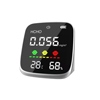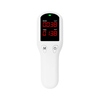Formaldehyde (CH2O) is a very common yet highly hazardous chemical in modern life and industrial production. It's widely used in construction materials, furniture manufacturing, and as a chemical feedstock. Long-term exposure can negatively impact human health.
This article provides a comprehensive overview covering "What is Formaldehyde (CH2O), its sources, hazards, detection, and prevention," and explains how to use Indoor Formaldehyde gas monitors and industrial Formaldehyde detectors to keep track of air quality in real-time.
1. What is Formaldehyde (CH2O)?
Formaldehyde is a colorless gas with a strong, pungent odor. Its chemical formula is CH2O, making it the simplest type of aldehyde compound. Industrially, it's commonly used to produce plastics, resins, adhesives, preservatives, and paints. Due to its strong reactivity and preservative properties, Formaldehyde is extremely widespread in manufacturing.
However, CH2O is not a safe substance. When released into the air, long-term inhalation can be harmful to human health. Concentrations are often above safe limits, especially in enclosed spaces like newly renovated rooms or vehicle interiors.
Common Uses:
- Building & Decoration Materials (Plywood, Particleboard, Wallpaper)
- Furniture Manufacturing (Adhesives, Surface Coatings)
- Textile Treatment (Wrinkle-resistance, Shrink-proofing)
- Medical & Chemical Industries (Disinfection, Preservation, Raw Material for Synthesis)
2. Main Sources of Formaldehyde Gas
Indoor Sources
In homes and offices, CH2O gas mainly comes from:
- Pressed-wood furniture & flooring: Like medium-density fiberboard (MDF) and laminated wood flooring.
- Paints & Adhesives: Urea-Formaldehyde resin in building materials releases Formaldehyde over long periods.
- Curtains, mattresses, sofas, and other fabrics: Some textiles use aldehyde-based compounds for wrinkle or mildew resistance.
- Cigarette smoke & combustion products: Smoking is a significant source of Formaldehyde release.
Industrial Sources
In factories, labs, or chemical plants, Formaldehyde is used to synthesize resins, plastics, and pharmaceutical intermediates. These sites can easily become sources of air pollution, making it essential to use industrial Formaldehyde detectors for continuous monitoring to protect worker safety.
3. Health Effects of Formaldehyde
Formaldehyde is a strong irritant and a known carcinogen. Its health impact depends on the concentration and duration of exposure.
- Short-term exposure can cause irritation to the eyes, throat, and nose, leading to symptoms like watery eyes, coughing, headaches, or chest tightness.
- Long-term exposure is more serious, potentially causing chronic respiratory diseases, skin allergies, immune system disorders, and even cancer.
The risks are higher for infants, pregnant women, and the elderly. Babies have faster metabolisms and developing immune systems, making them more susceptible to symptoms like coughing, sneezing, or sleep disturbances in environments with elevated Formaldehyde levels. Therefore, maintaining good air quality is crucial, both at home and in public spaces.
4. How to Detect Formaldehyde (CH2O)?
Laboratory Testing
Professional labs can provide accurate results, but the process is complex, time-consuming, and relatively expensive, making it unsuitable for daily monitoring.
Indoor Formaldehyde Gas Monitor Alarm
Thanks to advances in sensor technology, homeowners can now use indoor Formaldehyde gas monitors to check air quality in real-time.
For example, the GasDog Formaldehyde Monitor uses a high-sensitivity electrochemical sensor to display real-time Formaldehyde concentration (in ppm or mg/m³). Its advantages include:
- High-accuracy sensor with fast response.
- It can simultaneously monitor temperature, humidity, and VOC levels. Features sound and light alarms.
- Suitable for homes, offices, schools, hotels, etc.
| Item |  |
 |
 |
| SKU | GD1000-DM1013 | GD1000-RC3001 | GD1000-HCHO-1 |
| Gas | CH2O/HCHO | CH2O/HCHO & TVOC | CH2O/HCHO |
| Alarm | ✔ | ✔ | ✖ |
| WiFi | ✖ | ✖ | ✖ |
| T & RH | ✔ | ✖ | ✖ |
| Display | ✔ | ✔ | ✔ |
Industrial Formaldehyde Gas Detector
In chemical plants, laboratories, furniture factories, and other industrial settings, industrial-grade Formaldehyde monitoring systems are required. These devices typically feature:
- High measurement range and strong anti-interference capability.
- Support for RS485/4-20 mA output for easy connection to PLCs or remote monitoring systems.
- Audible/visual alarms and relay outputs to link with ventilation and alarm systems.
| Items | SKU | Measure Range | Resolution |
 |
GD200-CH2O | 0-10/20/50/100/500/1000ppm | 0.01ppm/0.1ppm/1ppm |
 |
GD300-CH2O | 0-10/20/50/100/500/1000ppm | 0.01ppm/0.1ppm/1ppm |
 |
GD700-CH2O | 0-10/20/50/100/500/1000ppm | 0.01ppm/0.1ppm/1ppm |
5. How to Reduce Formaldehyde Levels
If your detection results show high Formaldehyde levels, you can take these steps:
- Ventilate: Opening windows regularly effectively dilutes the Formaldehyde concentration in the air.
- Use an Air Purifier: Choose an air purifier with an activated carbon filter or photocatalytic oxidation technology to break down Formaldehyde molecules.
- Activated Carbon Adsorption: Activated charcoal can adsorb Formaldehyde, but it needs to be replaced once saturated.
- Control the Source: Use eco-friendly furniture, E0/E1 grade boards, and low-VOC paints to reduce Formaldehyde release at the source.
- Monitor Air Quality Continuously: Install an Air Quality Monitor or a GasDog Formaldehyde Detector to keep real-time tabs on your air and ensure a safe environment.
While common, Formaldehyde (CH2O) is a hidden, long-term threat in the air. It's invisible, but it can be continuously released in enclosed spaces, posing a potential health risk. Through scientific monitoring and timely action, we can effectively reduce Formaldehyde concentrations and ensure safer breathing. Whether at home or in the workplace, equipping yourself with reliable detection devices empowers you to understand your air quality in real-time, making every breath cleaner and safer.
